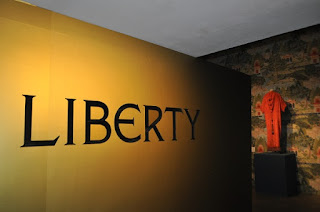I recall two years ago, the American heritage denim brand Levi’s teamed up with Liberty of London on a collection of women's denim separates that featured two new Liberty prints - created exclusively for the partnership. While the denim designs were sourced from Levi's archive, similarly, the garden flower prints were based on a Liberty pattern from the Seventies - redrawn with watercolour pencils and put into a repeat design, plus another print based on a Pointillist painting from the Liberty archive that dates back to 1940.
 |
| Exhibition banner featuring an example of an Art Nouveau design, from the book Liberty and Co. in the Fifties and Sixties, published by Antique Collectors Club. |
So when I heard that London’s Fashion and Textile Museum (FTM) will be opening a new major exhibition on Liberty, I seized an opportunity to have a sneak preview ahead of the official opening. With high hopes for a great experience, I was not disappointed that the exhibition offers great insights into its vast archive of prints, the stories behind them and the print house's importance in British fashion history up until now.
Liberty in Fashion, which opens on October 9th and runs until 28 February 2016 at the FTM and in Bermondsey (a stone’s throw from the Chard in London Bridge), charts its contribution to British fashion in its 140-year history, both that produced by the company and its impact on the work of other designers. This is the first retrospective on Liberty since the Victoria and Albert Museum’s 1975 exhibition to document Liberty’s first centenary.
The FTM exhibition not only highlights Liberty as a pioneering retailer of international standing (its Tudor-style Regent Street department store remains a major fashion and lifestyle shopping destination in London’s west end) and demonsstrate its influence through the decades and eras of successive art movements up to the present day.
Founded by Arthur Lasenby Liberty, the store began in 1875 originally as a warehouse selling coloured silks sourced from the Far East (when Japan opened up to trade with the West in the 1850s), North Africa and India, along with costumes, fans, china, lacquer and enamel wares. As its influence and strong identity in fabric patterns continued to grow, it became a department store offering not only fashion but interior objects and designs as well, including lacquerware, cloisonné enamel, oriental goods and then furniture.
While it celebrates Liberty as the fashionable place to shop, the exhibition also emphasizes its role as the source and originator of key trends in fashion history.
“Every garment in the exhibition has been carefully chosen to enable the Museum to represent the incredible range of textile designs created by the firm as well as to present an argument about why Liberty is always ‘in fashion’,” said Dennis.
As the visitor enters the main exhibition, you enter an area entitled A Dialogue with the East, and immediately presented with a selection of designs showing how Liberty took inspiration from the East for its own textiles and collections, including the kimono, which provided the basis for dressing gowns and wraps, and the burnous (long hooded cloak worn by Arabs).
The Aesthetic movement promoted a romantic, fluid way of dressing and the idea of hitoric and artistic dressing continued as an important element of the Liberty look. While garments made by Liberty were in demand, during the years of make-do-and-mend in the inter-world-war period, home dress-making was popular.
One fine example was a 1930s silk lamé home-made dress that had been altered and updated over time, as shown here on the right The print of the fashion used is in fact upside down and inside out. The fabric is a silk gauze block printed with metallic effect.
From Orientalism and Aesthetic dress in the 19th century, Liberty continues to play a key role through the Art Nouveau movement in early 20th century, and the exhibition also shows a revival of these styles since the 1950s.
 |
| Art Nouveau ptterns such as the Lotus were re-coloured in vivid shades during the 1950s and 60s. |
 |
| The art of smocking was rvived in early 1970s as part of the nosstalgic mood of the decade. |
Before the First World War, Liberty began producing delicate floral prints and this increased rapidly during the inter-war period. These have grown to become the archetypical Liberty print. Textiles such as Tana Lawn and Sungleam crepe were popular as lengths for the home sewer (like my mom) and as finished garments.
The Liberty Design Studio was established in the 1950s to produce and commission the best in patterned and woven textiles.
 |
| Swinging Liberty |
During the years of the Swinging 60s, Liberty was working with designers (including Mary Quant, Foal and Tuffin and Jean Muir), and into the 1970s, Liberty prints were once again rediscovered by a new generation of designers, not just in London but also in Paris, including Yves St Laurent.
 |
| 1970s Nostalgia. Dress in foreground is by Jeff Banks. |
 |
| Nike x Liberty |
 |
| Vivienne Westwood Red Label SS2013. Westwood used Rachel Pedder Smith's "Floral Eve" print silk design. |
All photos by Lucia Carpio for My Fashion Connect.










No comments:
Post a Comment